薪酬管理 专业术语(中英文对照)
- 格式:docx
- 大小:14.65 KB
- 文档页数:5
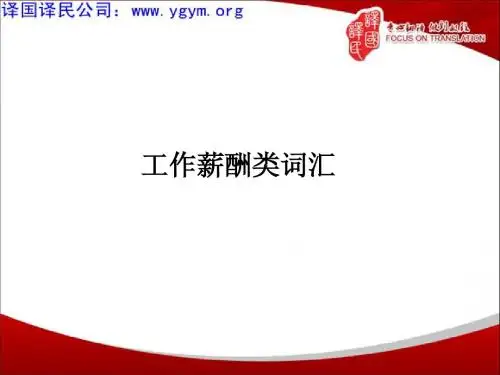
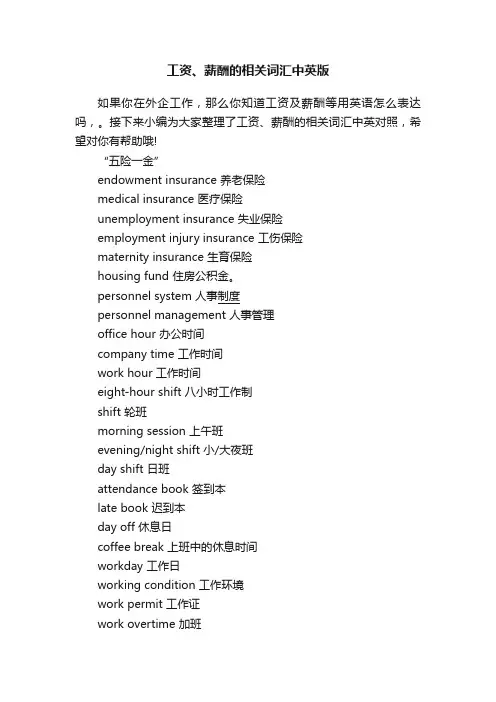
工资、薪酬的相关词汇中英版如果你在外企工作,那么你知道工资及薪酬等用英语怎么表达吗,。
接下来小编为大家整理了工资、薪酬的相关词汇中英对照,希望对你有帮助哦!“五险一金”endowment insurance 养老保险medical insurance 医疗保险unemployment insurance 失业保险employment injury insurance 工伤保险maternity insurance 生育保险housing fund 住房公积金。
personnel system 人事制度personnel management 人事管理office hour 办公时间company time 工作时间work hour 工作时间eight-hour shift 八小时工作制shift 轮班morning session 上午班evening/night shift 小/大夜班day shift 日班attendance book 签到本late book 迟到本day off 休息日coffee break 上班中的休息时间workday 工作日working condition 工作环境work permit 工作证work overtime 加班holiday rotation 节假日轮流值班traveling allowance(for official trip) 差旅费payroll 工资册salary 薪水 (指付给一个人的固定劳动补偿)wage 工资(为劳动或服务所付的报酬,尤指按天数、周或按工作量所付的薪酬)salary raise 加薪windfall 外快annual pension 年薪year-end bonus 年终奖bonus 奖金premium 红利overtime pay 加班费punch the clock 打卡time recorder 打卡机sneak out 开溜internship 实习on probation 试用probation staff 试用人员agreement of employment 聘书uation of employee 员工考核employee uation form 考核表merit pay 绩效工资dock pay 扣薪unpaid leave 无薪假before-tax salary 税前薪水income tax 所得税take-home pay/after-tax salary 税后净薪release pay 遣散费severance pay 解雇费salary deduction 罚薪casual leave 事假sick leave 病假。

薪酬管理专业术语1。
报酬—-指劳动者从事生产活动而获得的各种收入。
包括从各种来源开支的货币及实物工资,即单位以工资、福利形式以及其他各种形式从成本、费用或利润中支付给劳动者个人的工资性的报酬,以及个体和其他劳动者通过参加生产活动所获得的各种劳动报酬。
2.薪酬是员工因向所在的组织提供劳务而获得的各种形式的酬劳。
狭义的薪酬指货币和可以转化为货币的报酬。
广义的薪酬除了包括狭义的薪酬以外,还包括获得的各种非货币形式的满足。
3.总薪酬不仅包括企业向员工提供的经济性的报酬与福利,还包括为员工创造的良好的工作环境以及工作本身的内在特征、组织的特征等所带来的非经济性的心理效用.4.薪酬管理是在组织发展战略指导下,对员工薪酬支付原则、薪酬策略、薪酬水平、薪酬结构、薪酬构成进行确定、分配和调整的动态管理过程5.直接薪酬或称货币性薪酬,是指组织对员工占据组织的工作岗位并为组织做出贡献的现实做出的货币性或实物性的薪酬支付。
直接薪酬的内容有基本工资、加班及假日津贴、绩效资金、利润分享、股票期权等等。
一般来说,直接薪酬与员工的工作或技能价值及绩效紧密相关.6.间接薪酬又称福利薪酬,是指员工作为企业成员所享有的、企业为员工将来的退休生活及一些可能发生的不测事件(如疾病、事故)等所提供的经济保障,其费用部分或全部由企业承担.它往往不以货币形式直接支付,而多以实物或服务的形式支付。
7.基本薪酬又称“基本薪金”,是根据员工所承担或完成的工作本身或者是员工所具备的完成工作的技能向员工的支付的稳定性报酬,是员工收入的主要部分,也是计算其他薪酬性收入的基础。
8。
可变薪酬是短期激励和长期激励的组合。
可变薪酬=现金激励+短期激励+长期激励9.经营战略又称“经营单位战略”.经营战略是企业面对激烈变化、严峻挑战的环境,为求得长期生存和不断发展而进行的总体性谋划。
经营战略是在符合和保证实现企业使命的条件下,在充分利用环境中存在的各种机会和创造新机会的基础上,确定企业同环境的关系,规定企业从事的事业范围、成长方向和竞争对策,合理地调整企业结构和分配企业的全部资源.从其制定要求看,经营战略就是用机会和威胁评价现在和未来的环境,用优势和劣势评价企业现状,进而选择和确定企业的总体、长远目标,制定和抉择实现目标的行动方案.10.全面薪酬战略是指公司为达到组织战略目标奖励做出贡献的个人或团队的系统。
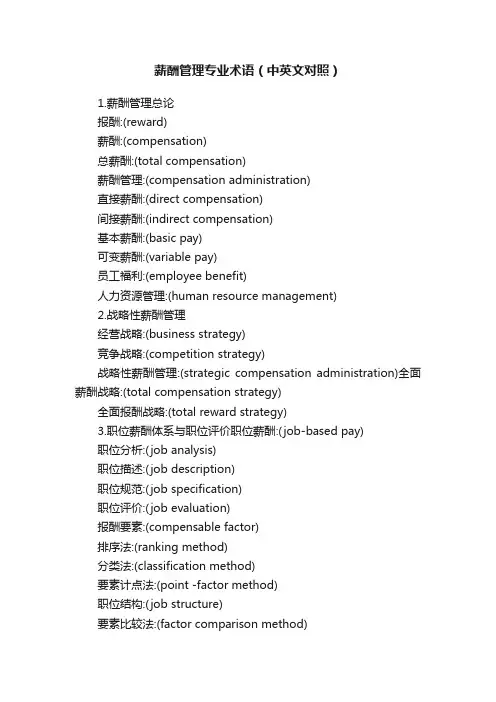
薪酬管理专业术语(中英文对照)1.薪酬管理总论报酬:(reward)薪酬:(compensation)总薪酬:(total compensation)薪酬管理:(compensation administration)直接薪酬:(direct compensation)间接薪酬:(indirect compensation)基本薪酬:(basic pay)可变薪酬:(variable pay)员工福利:(employee benefit)人力资源管理:(human resource management)2.战略性薪酬管理经营战略:(business strategy)竞争战略:(competition strategy)战略性薪酬管理:(strategic compensation administration)全面薪酬战略:(total compensation strategy)全面报酬战略:(total reward strategy)3.职位薪酬体系与职位评价职位薪酬:(job-based pay)职位分析:(job analysis)职位描述:(job description)职位规范:(job specification)职位评价:(job evaluation)报酬要素:(compensable factor)排序法:(ranking method)分类法:(classification method)要素计点法:(point -factor method)职位结构:(job structure)要素比较法:(factor comparison method)4.技能和能力薪酬体系深度技能:(depth skill)广度技能:(breadth skill)工作设计:(job design)技能等级:(skill level)技能认证:(skill certification)技能薪酬体系:(skill-based pay system)胜任能力:(competency)胜任能力模型:(competency model)能力薪酬:(competency-based pay)5. 薪酬水平及其外部竞争性薪酬水平:(pay level)外部竞争性:(external competitiveness)薪酬领袖政策:(lead policy)市场追随政策:(match policy)拖后政策:(lag policy)混合政策:(hybrid policy)劳动力市场:(labor market)薪酬调查:(total compensation survey)工作搜寻理论:(job search theory)信号模型理论:(signaling theory)补偿性工资差别理论:(compensating differentials theory)效率工资理论:(efficiency wage theory)保留工资理论:(reservation wage theory)6.薪酬结构设计薪酬结构:(pay structure)薪酬内部一致性:(internal consistency)薪酬区间中值:(midpoint of grade)薪酬比较比率:(compa-ratio)薪酬区间渗透度:(range penetration)薪酬区间叠幅:(range overlap)薪酬中值极差:(midpoint difference)宽带型薪酬结构:(broad-banding structure)薪酬变动范围(区间): (salary range)7.绩效奖励与认可计划利润分享计划:(profit sharing plans)收益分享计划:(gain sharing plans)成功分享计划:(success sharing plans)股票所有权计划:(stock owns plans)标准工时计划:(standard hour plan)员工持股计划:(ESOP)绩效加薪:(merit pay)一次性奖金:(lump sum bonus)绩效奖励计划:(pay for performance plans)个人绩效奖励计划:(individual incentive plans)群体绩效奖励计划:(group incentive plans)提案建议制度:(suggestion system)特殊绩效认可计划:(special performance recognizing plans)直接计件工资计划:(straight piece rate plan)差额计件工资计划:(differential piece rate plan) 8.员工福利管理员工福利:(employee benefit)法定社会保险:(social insurance)养老保险:(pension benefit)失业保险:(unemployment insurance)医疗保险:(medical insurance)工伤保险:(injury insurance)员工服务福利:(employee services)弹性福利计划:(flexible benefit plans)福利规划:(benefit planning)福利沟通:(benefit communication)生育保险:(maternity insurance)福利管理:(benefit administration)生育保险:(maternity insurance)福利管理:(benefit administration)企业补充养老金计划:(complementary pension plans)团体人寿保险计划:(group life insurance plans)健康医疗保险计划:(health care insurance plans) 9.特殊员工群体的薪酬管理特殊员工群体:(special groups)销售人员:(sales force)专业技术人员:(professionals)外派员工:(expatriate)管理人员:(manager)佣金制:(commission system)成熟曲线:(maturity curve)双重职业发展通道:(dual career path)10.薪酬预算、控制与沟通薪酬预算:(total compensation budget)宏观接近法:(macro-approach method)微观接近法:(micro-approach method)薪酬控制:(compensation control)薪酬沟通:(compensation communication)。
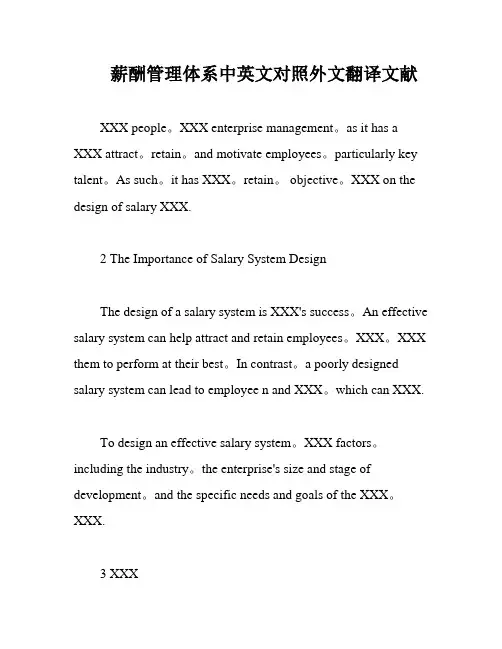
薪酬管理体系中英文对照外文翻译文献XXX people。
XXX enterprise management。
as it has a XXX attract。
retain。
and motivate employees。
particularly key talent。
As such。
it has XXX。
retain。
objective。
XXX on the design of salary XXX.2 The Importance of Salary System DesignThe design of a salary system is XXX's success。
An effective salary system can help attract and retain employees。
XXX。
XXX them to perform at their best。
In contrast。
a poorly designed salary system can lead to employee n and XXX。
which can XXX.To design an effective salary system。
XXX factors。
including the industry。
the enterprise's size and stage of development。
and the specific needs and goals of the XXX。
XXX.3 XXXXXX。
XXX incentives can help align the XXX with those of the enterprise and its shareholders。
XXX to perform at their best.When designing equity incentives。
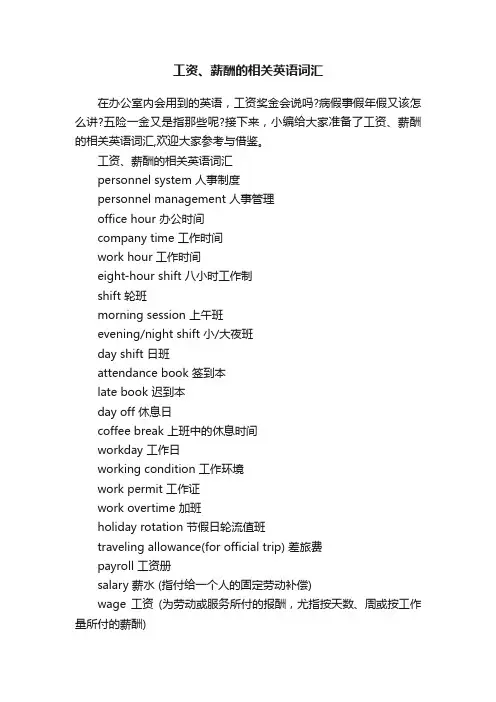
工资、薪酬的相关英语词汇在办公室内会用到的英语,工资奖金会说吗?病假事假年假又该怎么讲?五险一金又是指那些呢?接下来,小编给大家准备了工资、薪酬的相关英语词汇,欢迎大家参考与借鉴。
工资、薪酬的相关英语词汇personnel system 人事制度personnel management 人事管理office hour 办公时间company time 工作时间work hour 工作时间eight-hour shift 八小时工作制shift 轮班morning session 上午班evening/night shift 小/大夜班day shift 日班attendance book 签到本late book 迟到本day off 休息日coffee break 上班中的休息时间workday 工作日working condition 工作环境work permit 工作证work overtime 加班holiday rotation 节假日轮流值班traveling allowance(for official trip) 差旅费payroll 工资册salary 薪水 (指付给一个人的固定劳动补偿)wage 工资(为劳动或服务所付的报酬,尤指按天数、周或按工作量所付的薪酬)salary raise 加薪windfall 外快annual pension 年薪year-end bonus 年终奖bonus 奖金premium 红利overtime pay 加班费punch the clock 打卡time recorder 打卡机sneak out 开溜internship 实习on probation 试用probation staff 试用人员agreement of employment 聘书uation of employee 员工考核employee uation form 考核表merit pay 绩效工资dock pay 扣薪unpaid leave 无薪假before-tax salary 税前薪水income tax 所得税take-home pay/after-tax salary 税后净薪release pay 遣散费severance pay 解雇费salary deduction 罚薪casual leave 事假sick leave 病假“五险一金”endowment insurance 养老保险medical insurance 医疗保险unemployment insurance 失业保险employment injury insurance 工伤保险maternity insurance 生育保险housing fund 住房公积金。
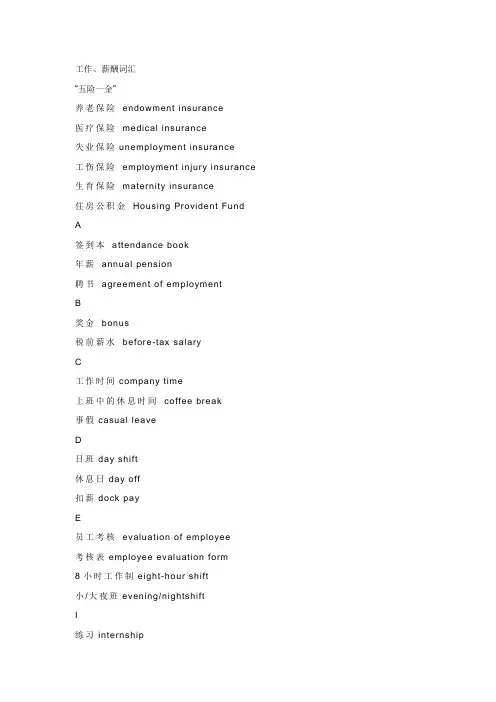
工作、薪酬词汇“五险一金”养老保险e ndo wme nt i nsuran ce医疗保险me dic al insuran ce失业保险une mp loy me nt i nsuran ce工伤保险e mplo y ment injur y in suran ce 生育保险ma terni ty insuran ce住房公积金Hous ing Prov ident Fu ndA签到本atte ndance book年薪ann ual p ensi on聘书agre e ment o f e mpl oy mentB奖金bon us税前薪水b efore-ta x sa laryC工作时间co mpa ny t i me上班中的休息时间c offee bre ak事假casu al leaveD日班day shift休息日da y off扣薪dock payE员工考核e val uatio n of e mplo yee考核表e mp loye e eva luat ion f or m8小时工作制ei ght-hour shif t小/大夜班e vening/nig htshi ftI练习inter nshi p所得税inco me ta xL迟到本late b ookM上午班morn ing sess ion绩效工资meri t payO办公时间off ice h our加班费o verti me pay试用on proba tionP人事制度pers onnel sy ste m人事管理pers onnel manage men t工资册pa yrol l红利pre miu m打卡punch the clo ck试用人员proba tion staffR遣散费re lease payS轮班shif t薪水(指付给一个人的固定劳动补偿)sal ary 加薪sal ary ra ise开溜snea k out解雇费severan ce pay罚薪sal ary ded uct ion病假si ck leaveT差旅费tr avel ing a ll o wan ce(for of fic ial trip)打卡机t i me re corder税后净薪take-ho me pay/after-ta x sa laryU无薪假unpa id leaveW工作时间wor k hour工作日workda y工作环境wor king cond it ion工作证work ing per mit加班work overt i me节假日轮流值班ho lida y rotat ion工资wage(为劳动或服务所付薪酬,尤指按小时、天数、周数、或按工作量所付薪酬)外快wi ndfal lY年终奖year-end b onus。
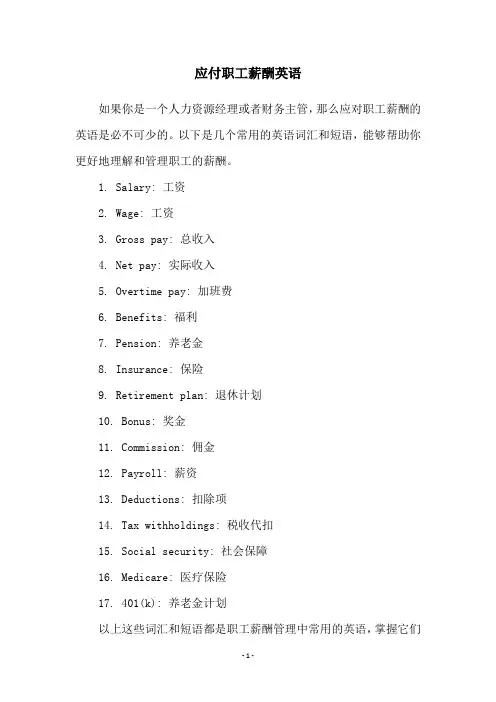
应付职工薪酬英语
如果你是一个人力资源经理或者财务主管,那么应对职工薪酬的英语是必不可少的。
以下是几个常用的英语词汇和短语,能够帮助你更好地理解和管理职工的薪酬。
1. Salary: 工资
2. Wage: 工资
3. Gross pay: 总收入
4. Net pay: 实际收入
5. Overtime pay: 加班费
6. Benefits: 福利
7. Pension: 养老金
8. Insurance: 保险
9. Retirement plan: 退休计划
10. Bonus: 奖金
11. Commission: 佣金
12. Payroll: 薪资
13. Deductions: 扣除项
14. Tax withholdings: 税收代扣
15. Social security: 社会保障
16. Medicare: 医疗保险
17. 401(k): 养老金计划
以上这些词汇和短语都是职工薪酬管理中常用的英语,掌握它们
能够帮助你更好地管理职工的薪酬。
同时,你还需要熟悉一些薪酬相关的法律法规,以确保你的公司在薪酬管理上合法合规。
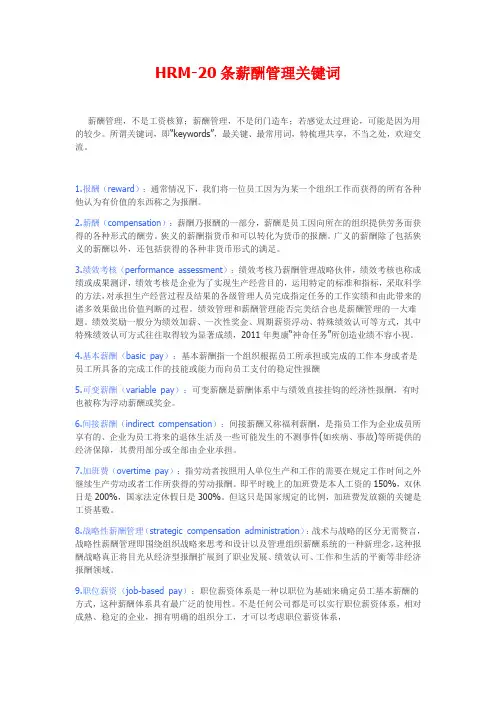
HRM-20条薪酬管理关键词薪酬管理,不是工资核算;薪酬管理,不是闭门造车;若感觉太过理论,可能是因为用的较少。
所谓关键词,即“keywords”,最关键、最常用词,特梳理共享,不当之处,欢迎交流。
1.报酬(reward):通常情况下,我们将一位员工因为为某一个组织工作而获得的所有各种他认为有价值的东西称之为报酬。
2.薪酬(compensation):薪酬乃报酬的一部分,薪酬是员工因向所在的组织提供劳务而获得的各种形式的酬劳。
狭义的薪酬指货币和可以转化为货币的报酬。
广义的薪酬除了包括狭义的薪酬以外,还包括获得的各种非货币形式的满足。
3.绩效考核(performance assessment):绩效考核乃薪酬管理战略伙伴,绩效考核也称成绩或成果测评,绩效考核是企业为了实现生产经营目的,运用特定的标准和指标,采取科学的方法,对承担生产经营过程及结果的各级管理人员完成指定任务的工作实绩和由此带来的诸多效果做出价值判断的过程。
绩效管理和薪酬管理能否完美结合也是薪酬管理的一大难题。
绩效奖励一般分为绩效加薪、一次性奖金、周期薪资浮动、特殊绩效认可等方式,其中特殊绩效认可方式往往取得较为显著成绩,2011年奥康“神奇任务”所创造业绩不容小视。
4.基本薪酬(basic pay):基本薪酬指一个组织根据员工所承担或完成的工作本身或者是员工所具备的完成工作的技能或能力而向员工支付的稳定性报酬5.可变薪酬(variable pay):可变薪酬是薪酬体系中与绩效直接挂钩的经济性报酬,有时也被称为浮动薪酬或奖金。
6.间接薪酬(indirect compensation):间接薪酬又称福利薪酬,是指员工作为企业成员所享有的、企业为员工将来的退休生活及一些可能发生的不测事件(如疾病、事故)等所提供的经济保障,其费用部分或全部由企业承担。
7.加班费(overtime pay):指劳动者按照用人单位生产和工作的需要在规定工作时间之外继续生产劳动或者工作所获得的劳动报酬。
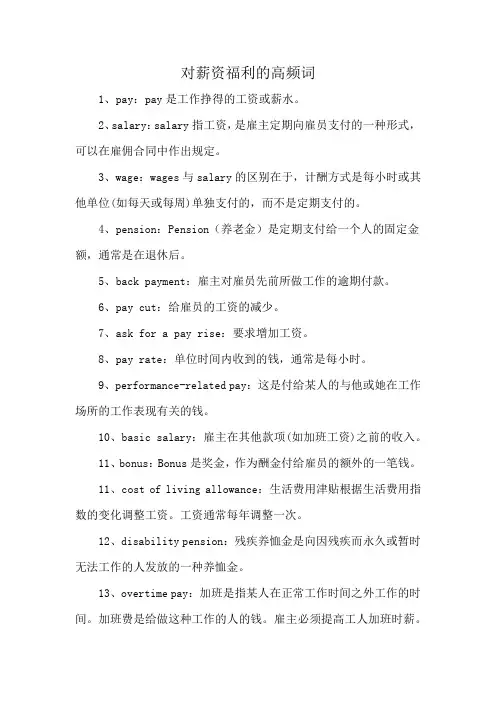
对薪资福利的高频词
1、pay:pay是工作挣得的工资或薪水。
2、salary:salary指工资,是雇主定期向雇员支付的一种形式,可以在雇佣合同中作出规定。
3、wage:wages与salary的区别在于,计酬方式是每小时或其他单位(如每天或每周)单独支付的,而不是定期支付的。
4、pension:Pension(养老金)是定期支付给一个人的固定金额,通常是在退休后。
5、back payment:雇主对雇员先前所做工作的逾期付款。
6、pay cut:给雇员的工资的减少。
7、ask for a pay rise:要求增加工资。
8、pay rate:单位时间内收到的钱,通常是每小时。
9、performance-related pay:这是付给某人的与他或她在工作场所的工作表现有关的钱。
10、basic salary:雇主在其他款项(如加班工资)之前的收入。
11、bonus:Bonus是奖金,作为酬金付给雇员的额外的一笔钱。
11、cost of living allowance:生活费用津贴根据生活费用指数的变化调整工资。
工资通常每年调整一次。
12、disability pension:残疾养恤金是向因残疾而永久或暂时无法工作的人发放的一种养恤金。
13、overtime pay:加班是指某人在正常工作时间之外工作的时间。
加班费是给做这种工作的人的钱。
雇主必须提高工人加班时薪。
14、severance pay:遣散费是指员工在离职时获得的工资和福利。
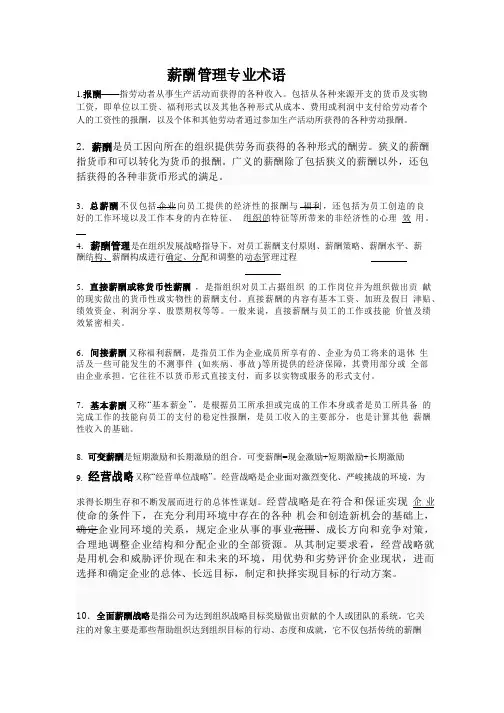
薪酬管理专业术语1.报酬——指劳动者从事生产活动而获得的各种收入。
包括从各种来源开支的货币及实物 工资,即单位以工资、福利形式以及其他各种形式从成本、费用或利润中支付给劳动者个 人的工资性的报酬,以及个体和其他劳动者通过参加生产活动所获得的各种劳动报酬。
3.总薪酬 不仅包括 企业 向员工提供的经济性的报酬与 福利 ,还包括为员工创造的良 好的工作环境以及工作本身的内在特征、 组织 的特征等所带来的非经济性的心理 效 用 。
4. 薪酬管理是在组织发展战略指导下,对员工薪酬支付原则、薪酬策略、薪酬水平、薪 酬结构、薪酬构成进行确定、分配和调整的动态管理过程5.直接薪酬或称货币性薪酬 ,是指组织对员工占据组织 的工作岗位并为组织做出贡 献的现实做出的货币性或实物性的薪酬支付。
直接薪酬的内容有基本工资、加班及假日 津贴、绩效资金、利润分享、股票期权等等。
一般来说,直接薪酬与员工的工作或技能 价值及绩效紧密相关。
6. 间接薪酬 又称福利薪酬,是指员工作为企业成员所享有的、企业为员工将来的退休 生活及一些可能发生的不测事件 (如疾病、事故 )等所提供的经济保障,其费用部分或 全部由企业承担。
它往往不以货币形式直接支付,而多以实物或服务的形式支付。
7. 基本薪酬 又称 “基本薪金 ”,是根据员工所承担或完成的工作本身或者是员工所具备 的完成工作的技能向员工的支付的稳定性报酬,是员工收入的主要部分,也是计算其他 薪酬性收入的基础。
8. 可变薪酬是短期激励和长期激励的组合。
可变薪酬=现金激励+短期激励+长期激励 2.薪酬是员工因向所在的组织提供劳务而获得的各种形式的酬劳。
狭义的薪酬 指货币和可以转化为货币的报酬。
广义的薪酬除了包括狭义的薪酬以外,还包 括获得的各种非货币形式的满足。
中英文对照外文翻译(文档含英文原文和中文翻译) Enterprises salary system design andperformance evaluationAbstractAny effective way of management must rely on a basis: people, all the staff of enterprises. Compensation system as an important aspect of enterprise management system, for an enterprise to attract, retain and motivate employees have a significant impact, attract, retain and motivate key talent, has become the core of the enterprise recognized goal. The compensation system design is not only an effective way to realize the core objective, is also an important content of modern enterprise development.Key words: salary system and equity incentive, senior executives, design1 IntroductionHuman capital to the enterprise wealth maximization, the greatest degree of retaining key talent, attract potential talent, the basic principals and successful is perfect competitive compensation system. With the concept of human capital is more and more people Heart, attract, retain and motivate key talent, has become the core of enterprise determine target, compensation system for enterprises An important aspect of the system, to attract talents play an important role. Compensation system design is an effective way to reality is the core objective, but also an important content of the development of the enterprise to modernization, so the height weight by enterprises Depending on the.2 Literature reviewEarly in the traditional compensation phase, the employers always minimize workers to cut costs as much as possible, and through this method make the Labor of workers have to work harder in order to get paid enough to make a living. William. First, Quesnay’s minimum wage theory is that wages and other commodities, there is a natural value, namely maintain staff minimum standard of living life information value,the minimum wage for workers does not depend on the enterprise or the employer's subjective desire, but the result of the competition in the market. The classical economists Muller believed that certain conditions, the total capital in the enterprise salary depends on the labor force and for the purchase of labor relationship between capital and other capital; For the payment of capital wage fund is difficult to change in the short term. Wages fund quantity depends on two factors: one is a worker, directly or indirectly, in the production of products and services production efficiency; the other one is in the process of production of these goods directly or indirectly employ labor quantity. With the development of era, the simple forms of employment have already can't satisfy the demand of the workers, so some interests to share views was put forward to motivate workers.On this basis, the Gantt invented the "complete tasks rewarded" system to perfect the incentive measures. Represented by Americaneconomist Becker’s theory of human capital school of thought argues that human capital is determined by the human capital investment, is present in the human body to the content of knowledge, skills, etc. Martin Weizmann share of economic theory that wages should be linked to corporate profits. Increase in profits, employee wages fund, increased profits, and employee wages fund. Between enterprises and employees is the key of the labor contract is not in a fixed wage of how many, but in the division of labor both sides share proportion. In modern compensation phase, the contents of the compensation has been changed, increased a lot of different compensation models, and more and more pay attention to employee's personal feelings and development, employees can even according to individual condition choose different salary portfolio model. Employees can be paid off on surface of the material and spiritual.3 Pay system overviewIn the past the traditional pay system, usually are business owners value orientation as the guide to carry on the design. With the continuous development of the overall market environment, in the modern enterprise management concept has also changed. They are aware of the established compensation system should adapt to the employee benefit as a starting point, the self-interest pursuit and employee demand together, to establish a set of enterprises and employees to maximize the interests of the two-way, so as to achieve win-win situation. Since the 90 s, the westerndeveloped economies in the enterprise owners and managers try to change the traditional form of compensation, relocation compensation system, the importance of also constantly try to innovate salary system of design and diversification.Performance pay system is established in accordance with the enterprise organization structure based on the results of the individual or team performance appraisal for salary distribution system. Total compensation is generally associated with individual or team performance. Now the enterprise model is used to combine individual performance and team performance. At the same time will be long term incentive and short-term incentive flexible model. In this kind of pay structure, contains a variety of forms of performance pay.Skill-based pay system on the basis of employees' skill determine employee wages level, and to the improvement of skills as their employees progress criteria. The compensation model can encourage employees to continuously learn new knowledge, to keep up with The Times, is the industry leader, when technology and equipment upgrades to the fastest response time to complete the change, and is helpful to form the learning corporate culture. If for flat organization structure, management jobs and opportunities for advancement are less, the compensation system can be very skillful professionals to make up for in terms of compensation. But with technical compensation system with theproblem is that the enterprise needs to pay for a large number of staff training, and if the participants of the training is not all to use knowledge in actual production, enterprises will not be able to obtain benefits, resulting in wasted costs.Total compensation is the unity of the material reward and spiritual reward. Among them, external compensation including all in monetary form of economic compensation, internal compensation includes not to substantial form of economic compensation, more focused on the return of spirit. John’s Lipoma at the end of last century proposed the compensation design, customization and diversity is more representative of the overall package. He should show that the basic wage, additional salary, salary welfare, work supplies allowance, bonus, promotion and development opportunities, psychological income, life quality, and individual factors that ten compensation factors into consideration, the formation of compensation system, the design method is different from the past traditional salary structure, is the biggest different compensation system design approach from the owner as the center to the worker as the center, employees can choose a suitable for their own pay combination, is no longer a passive receiver. In this compensation mode, economic compensation and the economical compensation together, paying equal attention to material and spiritual.4 The implementation of the compensation system designSalary survey is the key in the compensation system design. It is not only the necessary to understand the enterprise existing compensation system, is also the basis of compensation system design again. Salary survey should be real in-depth internal employee survey, as far as possible let employees at all levels give true feelings, make compensation system designers understand the staff for the specific demands of overall compensation. In had certain understanding of the current salary system and problems, will determine the compensation system on that basis to the general principles of design. Compensation system and the determination of design general principle also should according to the specific conditions of different enterprise itself to specific design. At the same time, according to the general principle to determine the scope of the staff at the level of compensation.Enterprise in selecting the most suitable for their own compensation system, the following sections are often the most concern, such as the division of different levels and at the same level of position within the sort, the post assessment results and with the duty staff due to personal quality differences between how to determine the pay difference. Enterprise in selecting the most suitable for their own compensation system, the following sections are often the most concern, such as the division of different levels and at the same level of position within thesort, the post assessment results and with the duty staff due to personal quality differences between how to determine the pay difference.Enterprise operators and management personnel representing the highest quality, at the same time they also foreign representative enterprise image, and holds the enterprise the way forward. They tend to have certain matter accumulation, more the pursuit of spiritual satisfaction and the realization of self-worth. For management personnel shall be designed to be scientific and reasonable compensation system, comprehensive consideration, not only give reasonable compensation in terms of material, at the same time to consider their spiritual pursuit.General manager's daily work mainly are transactional, administrative work, but is not directly concerned with the production related, so during the design compensation system will post wage and performance wage together, thus the personal salary combined with enterprise business objectives. To general managers to take a wider range of incentives, such as the annual performance review top employees equity incentives, encourage managers over fulfilled the goal, and form a competitive atmosphere of the company culture, drive the enterprise vitality. Increase the general manager’s shareholding proportion.For the use of EVA on the sales staff, can draw lessons from Tula bank ever take method, the sales staff to set up a commission systembased on EVA. Each sales staff receives a salary, in addition to qualification to get bonuses, the bonus amount depends on the "added value" has created. So that the program works: the company will be the added value of products are listed out, after distribution after the full cost of the product. The finance department monthly compiled a list of each product and added value of the net sales report. Each sales staff receives a copy of the report, as well as the use of the added value of the net total details of its own performance in the same format of monthly report. Further to deduct from the added value of net pay, perks and other fees and should share part of the management fee. After adjusting for these report line represents the added value.5 ConclusionIn the modern enterprises increasingly competitive today, talents become the key factor of enterprise long-term development more and more Business owners. And how to retain existing talent, and recruit more people of insight to join together create enterprise interest, become the compulsory subject of enterprise owners and management, and improve the compensation system is retaining talents and attracting talents essential link.企业薪酬体系设计与绩效评估Prasetya A摘要:任何一种行之有效的管理方式的运用都必须依赖于一个基础:人,企业的所有员工。
薪酬及绩效考核管理英语本文将介绍薪酬及绩效考核管理的相关英语词汇和表达方式。
在人力资源管理中,薪酬和绩效考核是重要的工作内容。
以下是一些相关的英语表达:1. 薪酬管理- Salary management- Compensation management- Payroll management- Wage management2. 绩效考核- Performance appraisal- Performance evaluation- Performance review- Performance assessment3. 绩效考核指标- Performance indicators- Key performance indicators (KPIs)- Metrics- Performance measures4. 薪酬结构- Salary structure- Pay structure- Compensation structure- Wage structure5. 薪酬福利- Compensation and benefits- Pay and benefits- Salary and benefits- Remuneration and benefits6. 绩效奖金- Performance bonus- Incentive bonus- Merit bonus- Performance-based pay7. 绩效改进计划- Performance improvement plan (PIP) - Performance development plan (PDP) - Performance enhancement plan- Performance growth plan8. 绩效管理流程- Performance management process- Performance appraisal process- Performance evaluation process- Performance review process以上是一些薪酬及绩效考核管理相关的英语表达,希望对大家有所帮助。
薪酬管理名词解释及选择:1、报酬〔Reward〕:通常情况下,我们将一位员工因为为某一个组织工作而获得的所有各种他认为有价值的东西统统称之为报酬。
2Compensation〕:指员工因雇用关系的存在而从企业那里获得的所有各种形式的货币收入,其中包括固定薪酬和浮动薪酬两大局部。
3、根本薪酬:一个组织根据员工所承当或完成的工作本身或者员工所具备的完成工作的技能或能力而向员工支付的相对稳定的经济报酬。
4、可变薪酬:是薪酬体系中及绩效直接挂钩的经济性报酬,有时也被称为浮动薪酬或奖金。
5、战略性薪酬管理:6、职位分析〔job analysis〕就是指了解一个职位并以一种格式把这种信息描述出来,从而使其他人能了解这个职位的过程。
7、工作分析:是通过对工作信息的收集及开发,来确定完成组织任务所需承当的职责和所应具备的技能,继而对工作进展描述和标准的系统工程。
8、工作要素:工作中不能再继续分解的最小动作单位。
9、任务:为到达某一明确目的所从事的一系列活动。
-要素集合10、职责:特定岗位上需要完成的一系列任务。
-任务集合11、职权:依法赋予的完成特定任务所需要的权力。
12、职务:主要职责在重要性及数量上相当的一组职位的集合或统称。
职务及职员不是一一对应,一个职务可能有几个人分担,即可能不止一个职位。
如:“副厂长〞的设置。
〔即工作是按规定担任的工作或为实现某一目的而从事的明确的工作行为,由一组主要职责相似的职位所组成。
〕13、职业:不同时间内,不同组织中,工作要求相似或职责平行〔相近、相当〕的职位集合,如会计、工程师等。
14、职业生涯:一个人在其生活中所经历的一系列职位、职务或者职业的集合或者总称。
15、职系〔职种〕:由两个或两个以上有相似特点的工作组成,指职责繁简难易、轻重大小及所需资格条件并不一样,但工作性质相似的所有职位集合。
如:人事行政、社会行政、财税行政等都属于不同的职系。
每个职系就是一个职位升迁的系统。
人力资源管理词汇英汉对照人力资源管理是现代企业管理中不可或缺的一部分。
在这个领域里,充满了各种各样的专业术语,这些术语不仅涵盖了招聘、培训、员工关系等方面的管理,还包括了各种政策、法规等方面的内容。
了解这些术语的意义对于职业发展和企业的管理都至关重要,因而丰富的词汇是必不可少的。
本文旨在提供一个人力资源管理词汇英汉对照表,帮助读者理解这一领域的术语。
一、人力资源管理基础术语1. Applicant:申请人2. Benefits:福利3. Employee:员工4. Human Resources:人力资源5. Job Analysis:工作分析6. Job Description:工作描述7. Job Requisition:工作申请8. Job Title:职称9. Orientation:培训10. Payroll:薪资管理11. Recruitment:招聘12. Resume:简历13. Selection:选拔二、培训和发展术语1. Coaching:教练式辅导2. Development Plan:发展计划3. E-Learning:电子学习4. In-Service Training:在职培训5. Management Development:管理发展6. On-The-Job Training:岗位培训7. Training Evaluation:培训评估8. Training Needs Assessment:培训需求评估三、员工福利术语1. Disability Insurance:残疾保险2. Employee Assistance Program (EAP):员工援助计划3. Employee Recognition Programs:员工认可计划4. Health Care Plan:医疗保险计划5. Life Insurance:人寿保险6. Paid Time Off (PTO):带薪休假7. Retirement Plan:退休计划8. Work-Life Balance Programs:工作与生活平衡计划四、薪酬和绩效术语1. Commission:佣金2. Compensation:薪酬3. Gross Pay:预扣税前工资4. Merit Pay:绩效工资5. Net Pay:税后工资6. Performance Appraisal:绩效评估7. Bonus:奖金8. Salary:薪资五、劳动关系术语1. Collective Bargaining:集体谈判2. Employee Contracts:员工合同3. Labor Union:工会4. Management Rights:管理权5. Strikes and Lockouts:罢工和停工6. Unfair Labor Practices:不公正劳动行为六、法规和政策术语1. Fair Labor Standards Act (FLSA):公平劳动标准法2. Americans with Disabilities Act (ADA):美国残疾人法案3. Equal Employment Opportunity Commission (EEOC):平等就业机会委员会4. Family and Medical Leave Act (FMLA):家庭和医疗假法5. Occupational Safety and Health Administration (OSHA):职业安全与健康管理局6. Social Security:社会保障以上提供的词汇是人力资源管理领域的常用术语,但是这个词汇表并不全面,因此读者需要通过不断的学习和实践,才能更好地理解和掌握这些术语。
人力资源术语英汉对照人力资源术语英汉对照随着全球化的发展和跨国企业的增多,英语作为国际语言,成为越来越多公司和组织开展工作的重要工具。
而作为一个专业领域,人力资源拥有大量的术语,掌握这些术语的英汉对照,不仅有助于人力资源工作者更好地理解和运用,也能提高英语水平和职业素养。
本篇文档将为大家介绍一些常用的人力资源术语的英汉对照。
一、招聘1. 面试(interview)2. 职位描述(job description)3. 职位空缺(job vacancy)4. 应聘者(applicant)5. 招聘广告(recruitment advertisement)6. 人才储备(talent pool)7. 招聘费用(recruiting cost)8. 聘用(hire)9. 投递简历(submit a resume)10. 背景调查(background check)二、培训和发展1. 培训课程(training course)2. 培训师(trainer)3. 培训计划(training plan)4. 培训成本(training cost)5. 培训效果评估(evaluation of training effect)6. 职业发展(career development)7. 职业规划(career planning)8. 岗位轮换(job rotation)9. 管理培训生(manage trainees)10. 继续教育(continuing education)三、绩效管理1. 绩效评估(performance evaluation)2. 绩效考核(performance appraisal)3. 绩效管理(performance management)4. 360度反馈(360-degree feedback)5. 职业评估(job evaluation)6. 目标管理(goal management)7. 工作计划(work plan)8. 员工评级(employee ratings)9. 绩效差异(performance variance)10. 薪酬管理(compensation management)四、福利和员工关系1. 福利计划(benefit plan)2. 加班费(overtime pay)3. 社会保险(social insurance)4. 离职补偿(severance pay)5. 休假制度(leave policy)6. 健康保险(health insurance)7. 灵活工作时间(flexible work time)8. 员工手册(employee handbook)9. 职工安全(employee safety)10. 员工投诉(employee complaints)五、人力资源管理1. 人事部门(human resources department)2. 人事记录(personnel records)3. 员工档案(employee file)4. 劳动合同(employment contract)5. 安全培训(safety training)6. 基本工资(base salary)7. 成本分析(cost analysis)8. 职业道德(professional ethics)9. 人力资源信息系统(human resources information system)10. 员工流动(employee turnover)六、其他术语1. 晋升(promotion)2. 辞职(resignation)3. 解雇(dismissal)4. 内部招聘(internal recruitment)5. 基本面试(basic interview)6. 团队建设(team-building)7. 职场文化(workplace culture)8. 项目管理(project management)9. 管理者培训(management training)10. 业务流程(business flow)以上只是人力资源术语的一小部分,掌握各种术语的英汉对照,对于人力资源从业者而言,是非常重要的。
最新资料,word文档,可以自由编辑!!精品文档下载【本页是封面,下载后可以删除!】C1.2 专业术语解释(一)薪酬相关术语分位值:分位值代表该数值对应的在同一自变量对应的因变量集合中所处的位置。
如中位(或50分位)代表该数值在某一自变量对应的因变量集合中处于中间位置。
本报告中主要应用到10分位,25分位,50分位(即中位),75分位,90分位。
10分位值:表示有10%的数据小于此数值,反映市场的低端水平。
25分位值:表示有25%的数据小于此数值,反映市场的较低端水平。
50分位值(中位值):表示有50%的数据小于此数值,反映市场的中等水平。
75分位值:表示有75%的数据小于此数值,反映市场的较高端水平。
90分位值:表示有90%的数据小于此数值,反映市场的高端水平。
平均值:所有数据的平均值,反映市场的平均水平。
偏离度:偏离度用于反映数据偏离某个标准的程度,其计算公式为:注:本报告中偏离度的概念反映各职位类别人员薪酬与市场薪酬之间的差距,以及反映单位薪酬与市场薪酬的差距。
结构分析:针对不同部门、不同层级或不同职位,对比各种薪酬项目相互比例的差异而采用的分析方法。
水平分析:对不同职位具体薪酬数值进行横向比较的一种分析方法。
分布状况:针对一组薪酬数据的数值大小,对从低到高的各区间段中出现的频率进行统计。
C1.3 专业术语解释(二)基本薪酬部分C1.4 专业术语解释(三)福利信息部分C2.1 主要宏观经济指标分析点评主要宏观经济指标数据分析图C5.1.1 会员单位【人力资源主管/科长】职位——职位说明书单位基本信息职位说明书职位类别: 人力资源管理类 职位层级: 主管级 职位名称: 人力资源主管/科长效管理体系;8、15 % 制定薪酬政策和晋升政策,组织提薪评审和晋升评审,制定公司福利政策,办理社会保障福利;9、 5 % 组织员工岗前培训、协助办理培训进修手续;10、 5 % 配合人力资源总监做好各种职系人员发展体系的建立,做好人员发展的日常管理工作;任职资格:教育背景:大专学历,专业培训经历:人力资源,行政管理工作经验:5年该职位相关工作经验外语要求:英语-一般电脑水平:精通其他要求:工作态度:对人及组织变化敏感,具有很强的沟通、协调和推进能力; 高度的敬业精神及高涨的工作激情,能接受高强度的工作,工作态度积极乐观; 善于与各类性格的人交往,待人公平。
1.薪酬管理总论
报酬:(reward)
薪酬:(compensation)
总薪酬:(total compensation)
薪酬管理:(compensation administration)
直接薪酬:(direct compensation)
间接薪酬:(indirect compensation)
基本薪酬:(basic pay)
可变薪酬:(variable pay)
员工福利:(employee benefit)
人力资源管理:(human resource management)
2.战略性薪酬管理
经营战略:(business strategy)
竞争战略:(competition strategy)
战略性薪酬管理:(strategic compensation administration)全面薪酬战略:(total compensation strategy)
全面报酬战略:(total reward strategy)
3.职位薪酬体系与职位评价职位薪酬:(job-based pay)
职位分析:(job analysis)
职位描述:(job description)
职位规范:(job specification)
职位评价:(job evaluation)
报酬要素:(compensable factor)
排序法:(ranking method)
分类法:(classification method)
要素计点法:(point -factor method)
职位结构:(job structure)
要素比较法:(factor comparison method)
4.技能和能力薪酬体系
深度技能:(depth skill)
广度技能:(breadth skill)
工作设计:(job design)
技能等级:(skill level)
技能认证:(skill certification)
技能薪酬体系:(skill-based pay system)
胜任能力:(competency)
胜任能力模型:(competency model)
能力薪酬:(competency-based pay)
5. 薪酬水平及其外部竞争性薪酬水平:(pay level)
外部竞争性:(external competitiveness)
薪酬领袖政策:(lead policy)
市场追随政策:(match policy)
拖后政策:(lag policy)
混合政策:(hybrid policy)
劳动力市场:(labor market)
薪酬调查:(total compensation survey)
工作搜寻理论:(job search theory)
信号模型理论:(signaling theory)
补偿性工资差别理论:(compensating differentials theory)效率工资理论:(efficiency wage theory)
保留工资理论:(reservation wage theory)
6.薪酬结构设计
薪酬结构:(pay structure)
薪酬内部一致性:(internal consistency)
薪酬区间中值:(midpoint of grade)
薪酬比较比率:(compa-ratio)
薪酬区间渗透度:(range penetration)
薪酬区间叠幅:(range overlap)
薪酬中值极差:(midpoint difference)
宽带型薪酬结构:(broad-banding structure)
薪酬变动范围(区间): (salary range)
7.绩效奖励与认可计划
利润分享计划:(profit sharing plans)
收益分享计划:(gain sharing plans)
成功分享计划:(success sharing plans)
股票所有权计划:(stock owns plans)
标准工时计划:(standard hour plan)
员工持股计划:(ESOP)
绩效加薪:(merit pay)
一次性奖金:(lump sum bonus)
绩效奖励计划:(pay for performance plans)
个人绩效奖励计划:(individual incentive plans)
群体绩效奖励计划:(group incentive plans)
提案建议制度:(suggestion system)
特殊绩效认可计划:(special performance recognizing plans)直接计件工资计划:(straight piece rate plan)
差额计件工资计划:(differential piece rate plan) 8.员工福利管理
员工福利:(employee benefit)
法定社会保险:(social insurance)
养老保险:(pension benefit)
失业保险:(unemployment insurance)
医疗保险:(medical insurance)
工伤保险:(injury insurance)
员工服务福利:(employee services)
弹性福利计划:(flexible benefit plans)
福利规划:(benefit planning)
福利沟通:(benefit communication)
生育保险:(maternity insurance)
福利管理:(benefit administration)
生育保险:(maternity insurance)
福利管理:(benefit administration)
企业补充养老金计划:(complementary pension plans)团体人寿保险计划:(group life insurance plans)
健康医疗保险计划:(health care insurance plans) 9.特殊员工群体的薪酬管理
特殊员工群体:(special groups)
销售人员:(sales force)
专业技术人员:(professionals)
外派员工:(expatriate)
管理人员:(manager)
佣金制:(commission system)
成熟曲线:(maturity curve)
双重职业发展通道:(dual career path)
10.薪酬预算、控制与沟通薪酬预算:(total compensation budget)
宏观接近法:(macro-approach method)
微观接近法:(micro-approach method)
薪酬控制:(compensation control)
薪酬沟通:(compensation communication)。